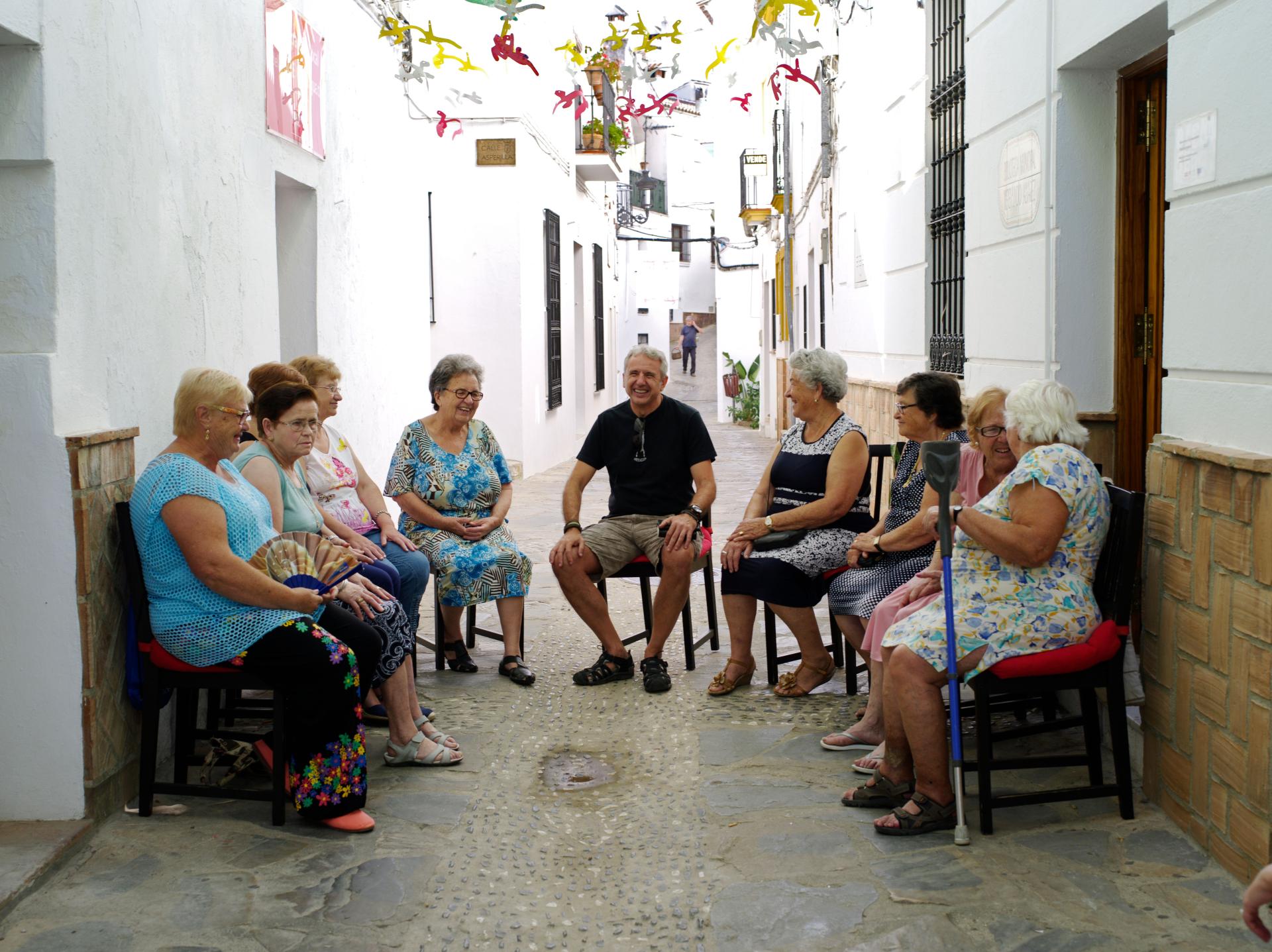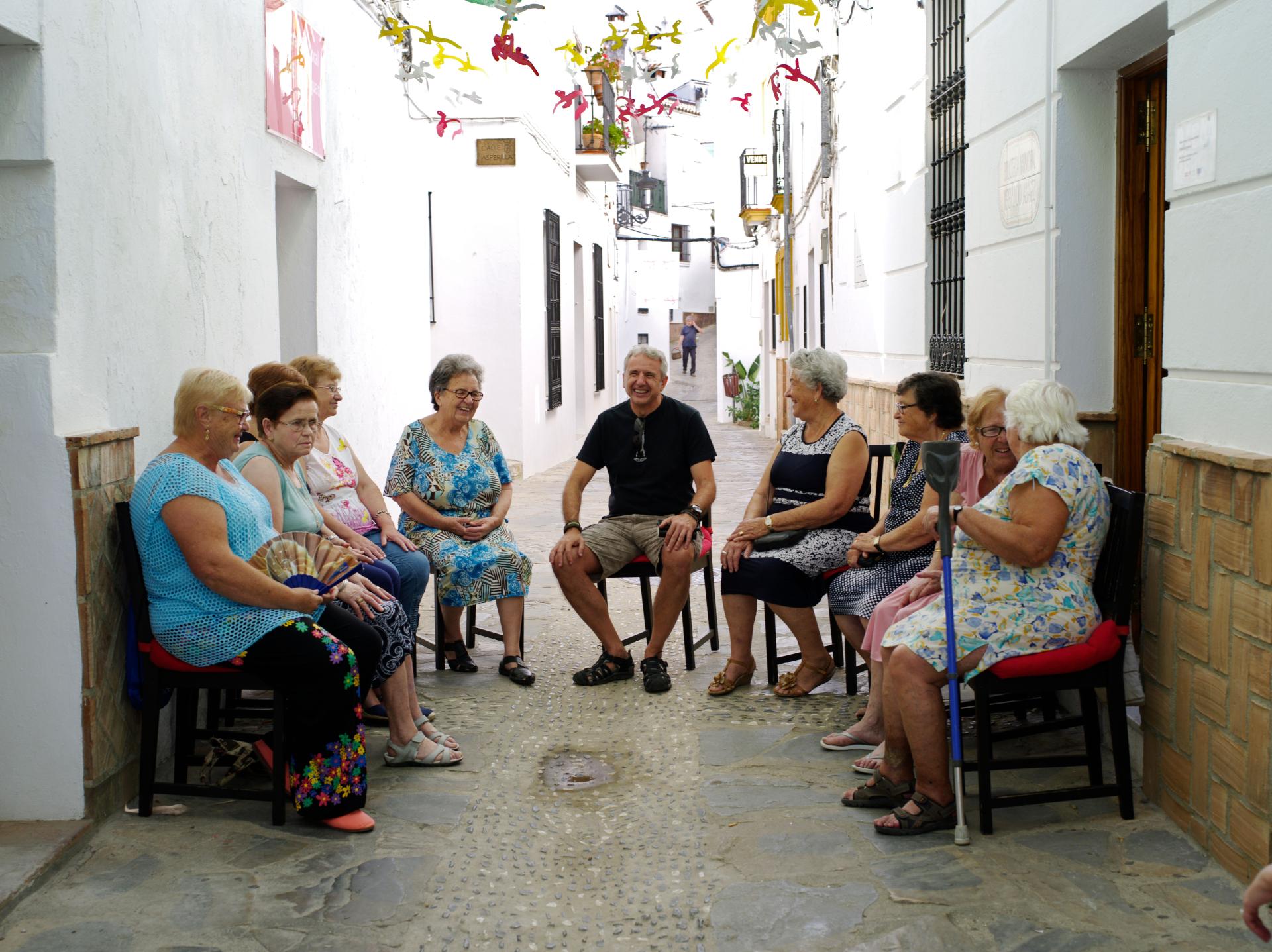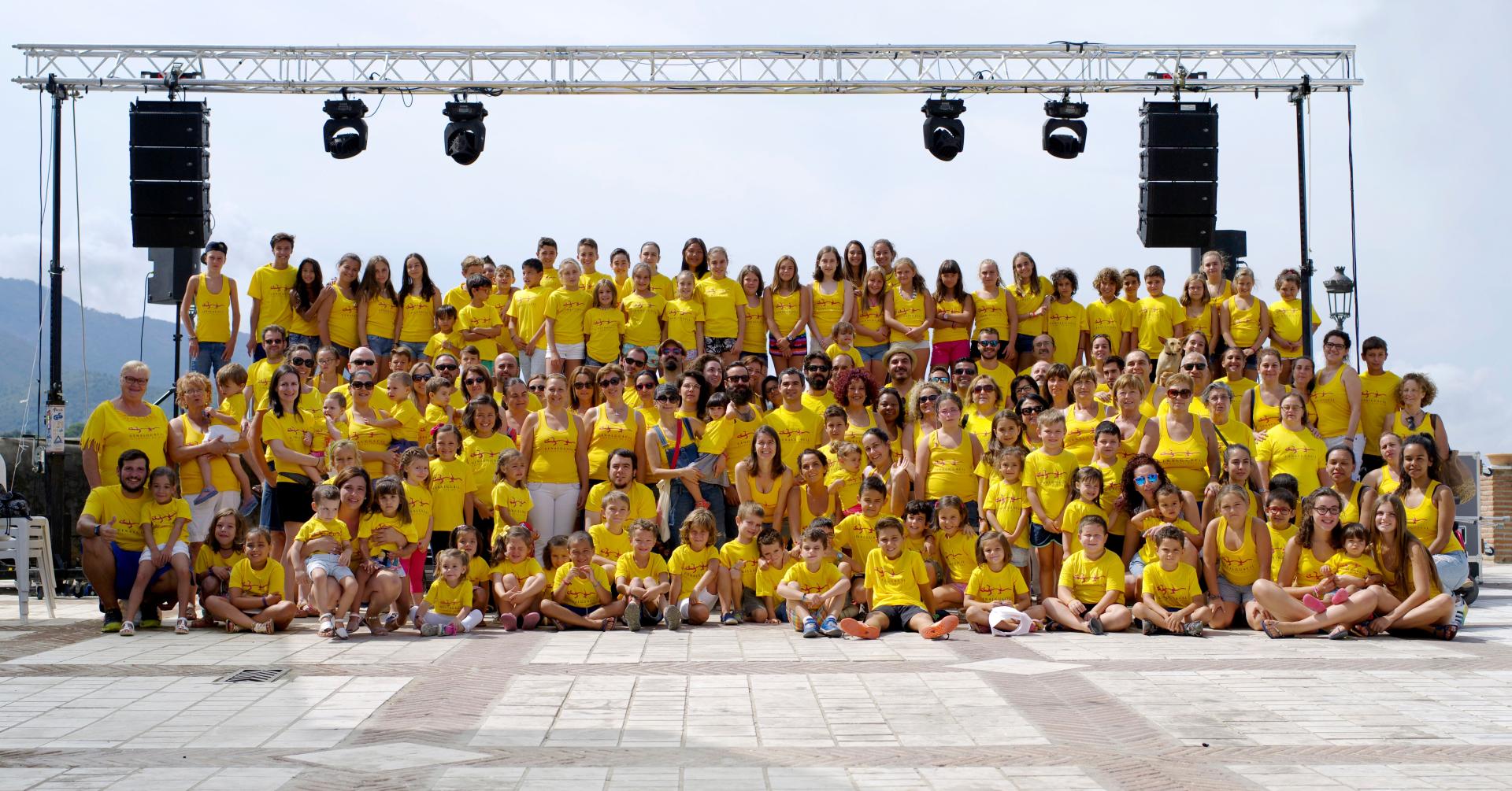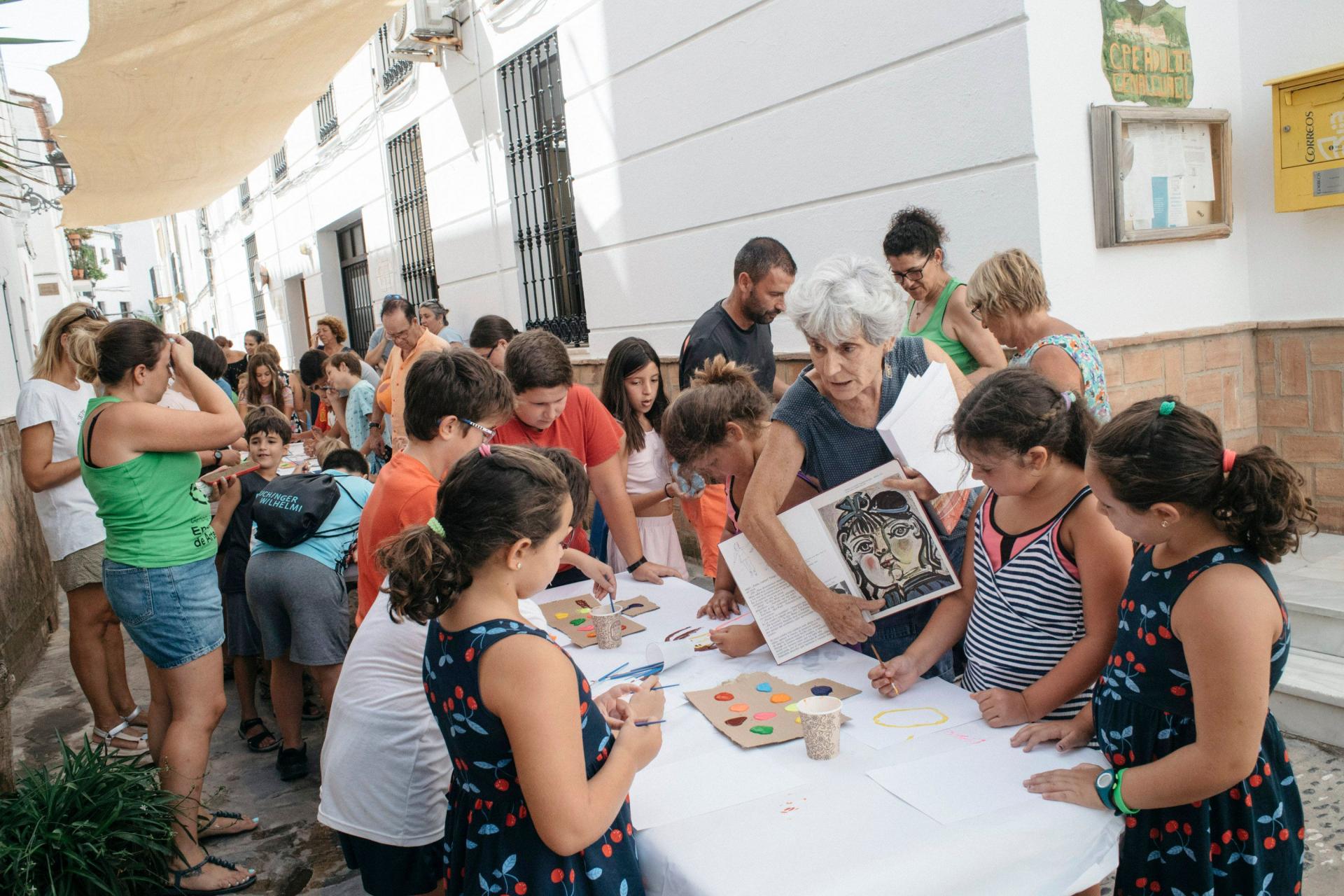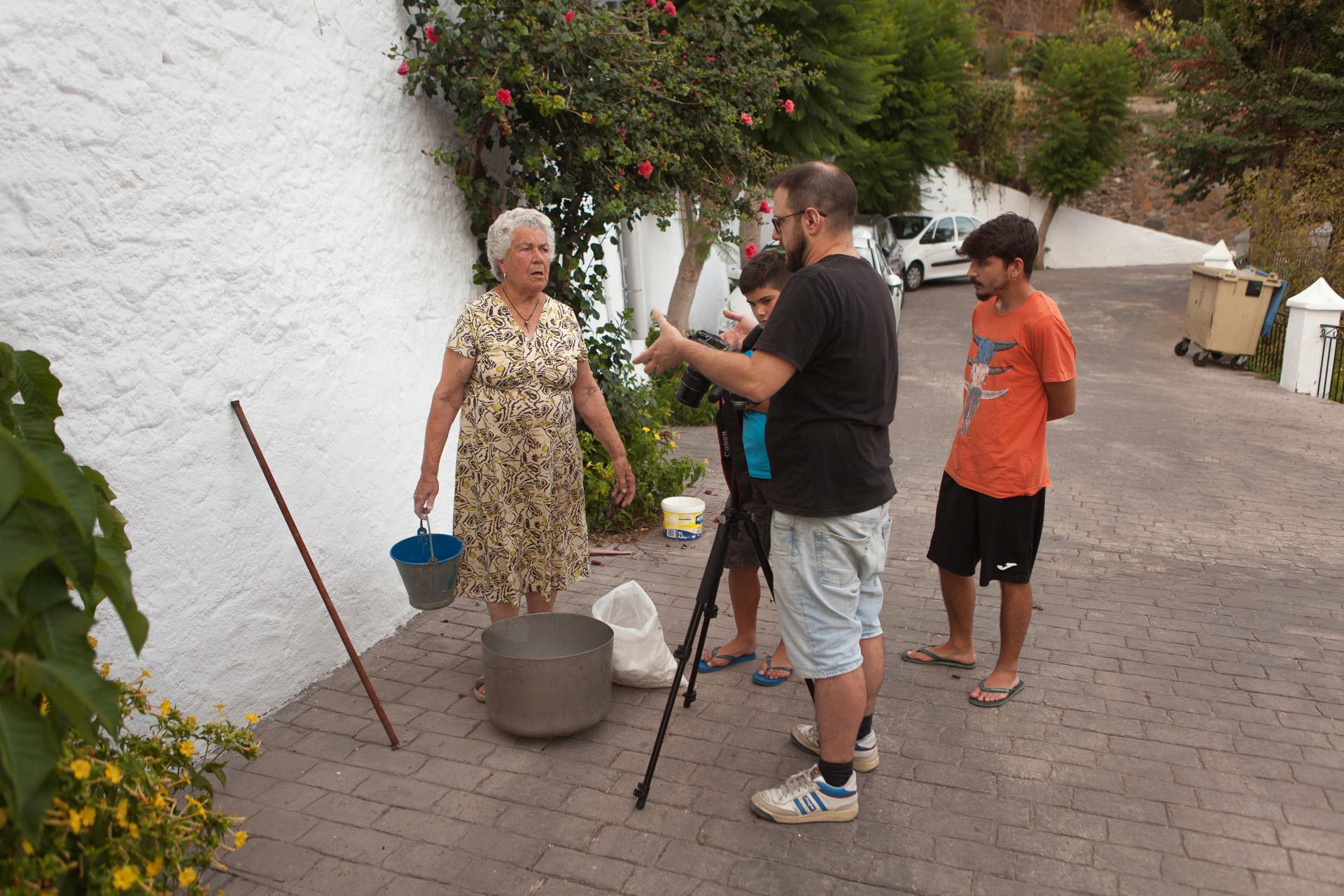Genalguacil Pueblo Museo
Basic information
Project Title
Genalguacil Pueblo Museo
Full project title
Genalguacil Pueblo Museo : art, tradition, culture, nature
Category
Regaining a sense of belonging
Project Description
Genalguacil, a rural community, has made contemporary art, tradition, culture and nature fundamental pillars for its development and transformation, as well as a model of growth that generates opportunities and values for the villagers.
Geographical Scope
Local
Project Region
Genalguacil , Spain
Urban or rural issues
Mainly rural
Physical or other transformations
It refers to other types of transformations (soft investment)
EU Programme or fund
No
Description of the project
Summary
Genalguacil is one of the "white villages", known for its whitewashed walls and classified as one of the most beautiful villages in Spain, but in the last 60 years it has lost two thirds of its population.
Since 1994, the municipality has been fighting this trend by commissioning contemporary art works that populate the entire village. Over a quarter of a century later, this small village in the Genal Valley stands out on the Spanish art scene for its firm commitment to contemporary creation as a driving force to generate ways to make life better in Europe's rural regions and to break people’s ideas or stereotypes about what being rural really means. As well as recognizing its value, identity and opportunity. Genalguacil Pueblo Museo´s activities are collaborative relationships between people, place, arts, fostering sustainable
innovation with and from the municipality.
Genalguacil Pueblo Museo has garnered national awards and international notoriety for many aspects of its operation, not least for its best practices, innovations and promotion of sustainability through culture e.g. 2018 recognised by the Observatorio de la Cultura en España, for impact. Genalguacil's reputation as a cultural destination has countered the trend of depopulation and demonstrated that value-driven cultural engagement is a vital future-oriented strategy. Genalguacil has undergone a transformation, and functions as a benchmark, being an open model for exploring how a local, rural economy can foster new artistic and cultural capacities in a way that transforms it into a 'village' of sustainable innovation.
Encuentros de Arte: artists and community, co-created outcomes live in the village streets.
Pueblo Museo
Fernando Centeno Museum of Contemporary Art
Arte Vivo : trans-locally and transversally, addressing global challenges.
LUMEN : dialogue of people with the village, light as a central element.
Fundación Genalguacil Pueblo Museo
LAB Genalguacil
Since 1994, the municipality has been fighting this trend by commissioning contemporary art works that populate the entire village. Over a quarter of a century later, this small village in the Genal Valley stands out on the Spanish art scene for its firm commitment to contemporary creation as a driving force to generate ways to make life better in Europe's rural regions and to break people’s ideas or stereotypes about what being rural really means. As well as recognizing its value, identity and opportunity. Genalguacil Pueblo Museo´s activities are collaborative relationships between people, place, arts, fostering sustainable
innovation with and from the municipality.
Genalguacil Pueblo Museo has garnered national awards and international notoriety for many aspects of its operation, not least for its best practices, innovations and promotion of sustainability through culture e.g. 2018 recognised by the Observatorio de la Cultura en España, for impact. Genalguacil's reputation as a cultural destination has countered the trend of depopulation and demonstrated that value-driven cultural engagement is a vital future-oriented strategy. Genalguacil has undergone a transformation, and functions as a benchmark, being an open model for exploring how a local, rural economy can foster new artistic and cultural capacities in a way that transforms it into a 'village' of sustainable innovation.
Encuentros de Arte: artists and community, co-created outcomes live in the village streets.
Pueblo Museo
Fernando Centeno Museum of Contemporary Art
Arte Vivo : trans-locally and transversally, addressing global challenges.
LUMEN : dialogue of people with the village, light as a central element.
Fundación Genalguacil Pueblo Museo
LAB Genalguacil
Key objectives for sustainability
The activities of Genalguacil Pueblo Museo are based on fostering a regenerative and circular approach founded in the value of the relationship between people and place, and care for the resources we have at hand. Genalguacil and the Genal Valley, are home to important natural and cultural capital that provide resources to the region itself and opportunities to rebalance territorial inequalities through the development of regenerative practices. Therefore, the programs of GPM work to unlock the relationship between the natural context and heritage practices, as ways to raise awareness and respond to the needs of sustainability. Importantly, making connections in how sustainability is practised in everyday life. Therefore, the commissioning process of the GPM programs in the first instance promotes the production of the contemporary art works by supporting the local economy (350 artworks). Working to create a circular approach, using local materials, creating local supply chains and co-creating works between artists and artisans.
For example, Arturo Comas project 10º (Arte Vivo, 2021) - explored how to see our reality in a different way, noticing things that are right in front of our eyes and we didn't see. Focusing on the slope on which Genalguacil is built, present in the everyday life of Genalguacileños. Arturo worked hand in hand with both local craftsmen and local residents to develop the works e.g. traditional chairs made in collaboration with a local carpenter and Francisco Rubio, craftsman and expert in natural fibres. Also the political and social role of Art, e.g. (Encuentros de Arte, 2022) Gala Knorr and Antonia, an elderly local, explored the relationship of heritage knowledge and sustainability in everyday lives ; also "Doubling Ecologies” (2021 Blanca de la Torre, Juan Zamora and Chen Wan-Jen) urging us to rethink our place in the world and our impact on it. Reminders of the need for collective action and a renewed view on our place in the world.
For example, Arturo Comas project 10º (Arte Vivo, 2021) - explored how to see our reality in a different way, noticing things that are right in front of our eyes and we didn't see. Focusing on the slope on which Genalguacil is built, present in the everyday life of Genalguacileños. Arturo worked hand in hand with both local craftsmen and local residents to develop the works e.g. traditional chairs made in collaboration with a local carpenter and Francisco Rubio, craftsman and expert in natural fibres. Also the political and social role of Art, e.g. (Encuentros de Arte, 2022) Gala Knorr and Antonia, an elderly local, explored the relationship of heritage knowledge and sustainability in everyday lives ; also "Doubling Ecologies” (2021 Blanca de la Torre, Juan Zamora and Chen Wan-Jen) urging us to rethink our place in the world and our impact on it. Reminders of the need for collective action and a renewed view on our place in the world.
Key objectives for aesthetics and quality
Genalguacil Pueblo Museo literally spills out into the streets, and is part of the everyday lives of the neighbours of the municipality. From the commissioning process, making of the artistic projects, to the opening of exhibitions are collaborative processes that bring together a diversity of people to exchange knowledge, make together and celebrate. For example, the stairways connecting the 3 floors of the Fernando Centeno Museum of Contemporary Art, displays the names of all the citizens of the municipality for the citizens are the members and co-creators of GPM. As you walk through the streets of the village you will spot contemporary art works in the windows of peoples house on their walls, all part of GPM collection and all part of the homes of the neighbours. For example, Fernando Renes (Arte Vivo, 2017) inter-wove works in the streets, windows, patios with the neighbours, the idea to be temporary and some to remain permanently. After a year, the time came to collect the pieces that were planned to be temporary. At this point, all the neighbours proposed that the works should stay where they were because they had grown fond of them and found it difficult to let them go. The “neighbours” proposed this to Fernando and an agreement was reached and the pieces remain as they were and will always remain that way - by being part of making as a shared experience GPM works to foster a sense of belonging between past and future and how they co-exist in “neighbours” everyday lives.
GPM has been made collectively over 30 years, and 2 years ago it founded Fundacion Genalguacil Pueblo Museo whose mission is to promote, develop and conserve the portfolio of GENALGUACIL PUEBLO MUSEO. Critically to extend the work of ARTS for re-population, to an open model for exploring how rural areas can foster new artistic and cultural capacities for sustainable innovation and fostering creative confidence in citizens of Genalguacil and beyond - to be agents of change.
GPM has been made collectively over 30 years, and 2 years ago it founded Fundacion Genalguacil Pueblo Museo whose mission is to promote, develop and conserve the portfolio of GENALGUACIL PUEBLO MUSEO. Critically to extend the work of ARTS for re-population, to an open model for exploring how rural areas can foster new artistic and cultural capacities for sustainable innovation and fostering creative confidence in citizens of Genalguacil and beyond - to be agents of change.
Key objectives for inclusion
If you asked someone what makes Genalguacil Pueblo Museo stand out , beyond its undeniable national and international reputation in contemporary art; it is the importance of relationships with and between people and place. The pillars of GPM, art, tradition, culture and nature are the framework by which “neighbours”, artists, artisans, combine knowledge into the process of making contemporary art, fostering belonging for a day, or a lifetime in a community caring for wellbeing. For example, (2018 Encuentros de Arte, Julio Anaya Cabanding, Benjamin Ramirez) co-creating with young people across the province of Málaga landscape painting workshops to explore relationships to our environment, connecting across cultural backgrounds in a common goal. "A Village," (2022 Encuentros de Arte, Jesús Madriñan) 400 photo-portraits of residents and visitors across countries making a visible community where everyone belongs. Museum as space for all e.g. 10º the upper room of the museum was inclined at 10º angle of the village; to be walked through to feel the experience of walking streets in Genalguacil, sharing daily experience of Genalguacil as works of art, like the open air museum (Encuentros de Arte, 2016 Miguel Angel Moreno Carretero) artist and children worked together to locate footballs where football is played in the village. GPM programs work for how we support our friends, families and communities especially for women with caring roles e.g. (2016 Encuentros de Arte, Lola Guerrera) able to work while caring for her son, mother, and brother with Down syndrome.
GPM has developed a process of radical inclusion and has achieved a confluence of knowledge between artisan, artist, neighbour, a catalyst for co-existence through art, and heritage that connects communities across identities. Preparing the community to face and learn how to resolve challenges such as climate change, sustainability - fostering the capabilities to transform and ensure resilience and growth.
GPM has developed a process of radical inclusion and has achieved a confluence of knowledge between artisan, artist, neighbour, a catalyst for co-existence through art, and heritage that connects communities across identities. Preparing the community to face and learn how to resolve challenges such as climate change, sustainability - fostering the capabilities to transform and ensure resilience and growth.
Results in relation to category
The stubborn depopulation that plagues this region, like so many other European rural areas, has been reversed through art: Contemporary art, together with tradition, culture and nature, are the driving force behind the GPM model and have generated sustainable outcomes and impact. One of the most significant achievements of the Genalguacil Pueblo Museo project is the heritage value that has resulted from research, active community participation, and engagement of visitors across cultures - as well as generating a circular economy approach through the programs that are developed and delivered throughout the year. GPM has achieved the creation of new works that have become part of the cultural heritage of the community, either in the collection of the Contemporary Art Museum or in the streets of the village, known as "Pueblo Museo." Critically and after decades of loss of inhabitants, the population has grown again.
PORTFOLIO of Outcomes, Impact:
OUTCOMES:
Encuentros de Arte
Pueblo Museo
Fernando Centeno Museum of Contemporary Art
Arte Vivo
LUMEN
Encuentros Ceramistas
Fundación Genalguacil Pueblo Museo
LAB Genalguacil : International Rural Innovation Laboratory
Over 200 artists
350 art works
20,000 visitors per year
International network of partners : academia, business, policy, civil society, arts, culture
Observatorio de Cultura
IMPACT:
Population +3% increase
School saved (20 pupils)
New business e.g. Marie Poirier Designer , Alvaro Gross Artisan shoe-maker, Sebastian Hedgecoe Photographer
PORTFOLIO of Outcomes, Impact:
OUTCOMES:
Encuentros de Arte
Pueblo Museo
Fernando Centeno Museum of Contemporary Art
Arte Vivo
LUMEN
Encuentros Ceramistas
Fundación Genalguacil Pueblo Museo
LAB Genalguacil : International Rural Innovation Laboratory
Over 200 artists
350 art works
20,000 visitors per year
International network of partners : academia, business, policy, civil society, arts, culture
Observatorio de Cultura
IMPACT:
Population +3% increase
School saved (20 pupils)
New business e.g. Marie Poirier Designer , Alvaro Gross Artisan shoe-maker, Sebastian Hedgecoe Photographer
How Citizens benefit
GPM has been made possible by the involvement of citizens, it is a truly bottom up project driven by the needs of a small rural village to fight depopulation, through its own collective actions - and by reaching out to artists to build relationships that engage directly with the municipality's heritage, natural environments and traditions. GPM success has been driven by the intrinsic commitment of its residents, whose dedication and active participation have made it possible. Since the beginning, each “neighbour” has played an essential role, as researchers, volunteers, and collaborators. Everyone has been a proactive agent in an open process of social innovation. In Genalguacil contemporary art goes beyond the art for contemplation, it is an everyday shared process change. All programs are founded in participatory activities; this is the driving force of a model that generates opportunities and values for the community.
For example, "Vestiges," (2014 Encuentros de Arte, Daniel Silvo) collaborative workshops to reproduce famous contemporary works - to encourage intergenerational learning and democratise contemporary art making a shared space of critical and creative doing. These shared activities foster confidence e.g. a school trip to museums in Malaga the teachers commented on how the children of Genalguacil could engage and discuss arts, culture in a distinct way.
As well the opportunity that contemporary art provides to foster “creative confidence” - the museum is the community's co-created space for learning and experimenting and the community organises educational activities with kids and adults. The community has developed creative workshops from painting, photography to embroidery to support reflection, independent thinking and the experience of expression across different techniques. In addition, it catalyses a sense of shared pride in the local, providing a shared positive perspective on challenges as opportunities for rural communities.
For example, "Vestiges," (2014 Encuentros de Arte, Daniel Silvo) collaborative workshops to reproduce famous contemporary works - to encourage intergenerational learning and democratise contemporary art making a shared space of critical and creative doing. These shared activities foster confidence e.g. a school trip to museums in Malaga the teachers commented on how the children of Genalguacil could engage and discuss arts, culture in a distinct way.
As well the opportunity that contemporary art provides to foster “creative confidence” - the museum is the community's co-created space for learning and experimenting and the community organises educational activities with kids and adults. The community has developed creative workshops from painting, photography to embroidery to support reflection, independent thinking and the experience of expression across different techniques. In addition, it catalyses a sense of shared pride in the local, providing a shared positive perspective on challenges as opportunities for rural communities.
Physical or other transformations
It refers to other types of transformations (soft investment)
Innovative character
Governance as an enabler: The story Miguel Angel Herrera Gutierrez (Mayor of Genalguacil) often shares is of the Cuckoo, challenges of rural regions cannot be answered by top down centralised policies, it is generating local solutions as active communities. GPM´s relationships between policy, community, academia, and business and collaborative co-creation of contemporary art over 30 years established governance practices as catalysts for rural development and inspiration for other rural communities. E.g. 2023 Genalguacil recognised for inclusive, and innovative practices in local Governance in support of GPM. (Andalusian Federation of Municipalities and Provinces)
Shared Creativity : GPM embodies the creative capability of locals, artists, artisans, making the GPM contemporary art collection a co-created cultural heritage asset. Countering the “urban creative class” and “individual creative genius” GPM is made by a diversity of people working together to generate opportunities.
Rural as today's futures: GPM counters the dominant narrative of the “urban hotspot” as the drivers of innovation and demonstrates value-driven cultural engagement is a vital future-oriented strategy. GPM, an example of how we find innovation where we least expect it, preparing new perspectives for green, digital, and social transition from and with Europe's rural communities.
Ecosystem as relationships: GPM is a joint work of collective intelligence, all people have the opportunity to be part of a space where equality is what matters in shaping an ecosystem that fosters trust, flexibility and confidence for transversal knowledge exchange. A people first approach, GPM activities are genuinely co-created.
Regenerative practices: GPM supports practices that develop local and circular economies, based on local first, and renewal of how we use resources. Its core developing community, wellbeing and equality of opportunity - through arts, with from rural Europe.
Shared Creativity : GPM embodies the creative capability of locals, artists, artisans, making the GPM contemporary art collection a co-created cultural heritage asset. Countering the “urban creative class” and “individual creative genius” GPM is made by a diversity of people working together to generate opportunities.
Rural as today's futures: GPM counters the dominant narrative of the “urban hotspot” as the drivers of innovation and demonstrates value-driven cultural engagement is a vital future-oriented strategy. GPM, an example of how we find innovation where we least expect it, preparing new perspectives for green, digital, and social transition from and with Europe's rural communities.
Ecosystem as relationships: GPM is a joint work of collective intelligence, all people have the opportunity to be part of a space where equality is what matters in shaping an ecosystem that fosters trust, flexibility and confidence for transversal knowledge exchange. A people first approach, GPM activities are genuinely co-created.
Regenerative practices: GPM supports practices that develop local and circular economies, based on local first, and renewal of how we use resources. Its core developing community, wellbeing and equality of opportunity - through arts, with from rural Europe.
Disciplines/knowledge reflected
The production of the contemporary art works and the collection Genalguacil Pueblo Museo - are co-created by a transdisciplinary approach. Each project is produced by combining a diversity of knowledge and practices, the critical factor in the work of GPM is this transdiscipline combination of local and heritage knowledge of “neighbours” with artists, artisans, curators, researchers, policy makers. For example, “De Ley” (Arte Vivo 2022, Pablo Capitan del Rio, Rosell Meseguer) revisiting the rich mineralogical history of Genalguacil the artists working hand in hand with Secundino Álvarez Gutiérrez, a researcher and scholar of local history and rediscovered lost heritage of the region, from the Phoenician times called “morteretes”. Working together to piece together this local history mixing oral histories, documentary photographs, scientific evidence, records. A similar approach “Cal.Rito, memoria e dentidad” Antonio Blázquez y Antonio Montesinos (Arte Vivo, 2021) explored with Isabel Macias Romero, Antonia Moreno Gómez, Isabel Velazquez Jurado and more the tradition and practices of using limestone to paint houses - revealing the roots of this tradition and the importance of the women in this practice - these approaches recognise expertise as equal - the importance of oral history, memories and local knowledge as part social value of people and place. These projects were able to discover lost heritage and manifest them in contemporary art works as a shared way of the local community re-getting to know their own context.
Methodology used
The Genalguacil Pueblo Museo method is based on Culture’s transformative impact (United Nations resolutions on culture and sustainable development).
GPM methodological toolkit are:
Collaborative Programs :
Encuentros de Arte: artists and community, co-created outcomes live in the village streets.
Arte Vivo : trans-locally and transversally, addressing global challenges.
LUMEN : dialogue of people with the village, light as a central element
Collaborative Spaces:
Pueblo Museo : Open air Museum
Fernando Centeno Museum of Contemporary Art
These are conceptually framed by the Genalguacil Pueblo Museo four pillars: contemporary art, tradition, culture and nature.
GPM methodological toolkit are:
Collaborative Programs :
Encuentros de Arte: artists and community, co-created outcomes live in the village streets.
Arte Vivo : trans-locally and transversally, addressing global challenges.
LUMEN : dialogue of people with the village, light as a central element
Collaborative Spaces:
Pueblo Museo : Open air Museum
Fernando Centeno Museum of Contemporary Art
These are conceptually framed by the Genalguacil Pueblo Museo four pillars: contemporary art, tradition, culture and nature.
How stakeholders are engaged
Genalguacil Pueblo Museo fosters “rural activism”, through its programs it engages with stakeholders from local groups, and national organisations to international partners to raise awareness, exchange knowledge and drive change from and for rural areas while developing competencies and networks for cultural driven innovation. GPM works with stakeholders from culture, policy, academia , business and civil society. For example, GPM is the only social innovation project at ARCO Madrid (international contemporary art fair) where GPM operates as a platform to promote the project, as well as the emerging artists across its programs while raising awareness for the role of arts and community in transformation and innovation. GPM works closely with policy organisations at local, regional and national levels e.g. Town Hall and Municipality of Genalguacil, Andalusian Federation of Municipalities and Provinces
(FAMP) connecting with other municipalities across Spain - to share good practice, promote local action, and form networks. GPM via its Foundation and LAB has strategic partnerships with national ministries (Ministry for Demographic Challenge and Ecological Transition), and European initiatives such as Rural Pact, EIT Culture and Creativity. It works closely with academic partners e.g. Norwegian University of Science and Technology, University of Malaga to provide real-world lab context for students and researchers to work with the local community on finding and prototyping new economic models. As “rural activists” the role of the media is critical to share stories to as many communities as possible GPM works closely with regional, national and international media to raise awareness of the rural, and arts and culture driven innovation e.g. from regional newspaper coverage and features on National Spanish television to the articles in New York Times.
(FAMP) connecting with other municipalities across Spain - to share good practice, promote local action, and form networks. GPM via its Foundation and LAB has strategic partnerships with national ministries (Ministry for Demographic Challenge and Ecological Transition), and European initiatives such as Rural Pact, EIT Culture and Creativity. It works closely with academic partners e.g. Norwegian University of Science and Technology, University of Malaga to provide real-world lab context for students and researchers to work with the local community on finding and prototyping new economic models. As “rural activists” the role of the media is critical to share stories to as many communities as possible GPM works closely with regional, national and international media to raise awareness of the rural, and arts and culture driven innovation e.g. from regional newspaper coverage and features on National Spanish television to the articles in New York Times.
Global challenges
Demographic challenge : This challenge is acutely manifest with the trend towards depopulation in rural regions. Large areas of rural Spain face this global challenge, and the Valle del Genal in which Genalguacil is located is particularly plagued by this trend. Depopulation is a social, environmental and heritage problem - depopulation as a demographic challenge is also one of equality, in some sense a democratic challenge. As such real solutions must come from the local, from the protagonists in the rural regions, fostering solutions of collective effort. As such GPM, is local action through art for repopulation, a 30 year fight against depopulation to regenerate cultural, social, economic, environmental and heritage value - to re-balance equality of opportunity. (SDGS 10, 11, 16, 5, 3)
Green transition : Andalusia is at the forefront of the climate crisis plagued by drought, and wildfires - GPM approach mobilises the cultural, political and social role of Art, in the first instance as a daily reminder of the need for collective action and a renewed perspective on our place in the world. In addition, rural regions are often associated with “extractive economics”; as such GPM activities have been to support the creation of local value chains combining local materials and expertise. In addition, also working to support activities that move beyond just primary materials that are exported elsewhere for production to how the combination of local expertise and materials can become cultural, social and economic value for the community. This work is being expanded upon by the Foundation, and LAB Genalguacil. (SDGS 12, 13, 15)
Green transition : Andalusia is at the forefront of the climate crisis plagued by drought, and wildfires - GPM approach mobilises the cultural, political and social role of Art, in the first instance as a daily reminder of the need for collective action and a renewed perspective on our place in the world. In addition, rural regions are often associated with “extractive economics”; as such GPM activities have been to support the creation of local value chains combining local materials and expertise. In addition, also working to support activities that move beyond just primary materials that are exported elsewhere for production to how the combination of local expertise and materials can become cultural, social and economic value for the community. This work is being expanded upon by the Foundation, and LAB Genalguacil. (SDGS 12, 13, 15)
Learning transferred to other parties
ECOSYSTEM approach : GPM´s way of working is participatory and multi-agent, the ecosystem approach developed focuses on enabling the exchange of knowledge in a community, as well as between communities in other rural regions affected by the issues of depopulation. It starts with people first, and the methods by which relationships at a local level can be fostered between locals, artists, artisans, policy makers, academics. It uses contemporary art, in relationship to heritage and nature as a bridge between a diversity of people. GPM¨s clear communication strategy across press and social media has effectively raised awareness of the GPM approach to rural transformation and development e.g.s are available in the supporting documents.
Critically, the now over a quarter of a century old program of Los Encuentros de Arte has fostered a network of artists who through their experience in Genalguacil have developed approaches to how contemporary art can be part of enabling social innovation with a community. The learning from these approaches and methods are integral to GPM “rural activism” and the “open source” nature of its activities. As such, to enable knowledge exchange through Europe's Rural communities the Foundation Genalguacil Pueblo Museo is developing an Artistic Research Design developed in a rural context - with the collaboration of local residents, artists, curators, academics, and policy makers. This is a new creative, systemic, transferable and reproducible approach; to be shared with Europe's rural communities to foster inclusive, sustainable and aesthetic approaches to rural innovation. Significantly, it is a method available to all of the arts and creative disciplines.
Critically, the now over a quarter of a century old program of Los Encuentros de Arte has fostered a network of artists who through their experience in Genalguacil have developed approaches to how contemporary art can be part of enabling social innovation with a community. The learning from these approaches and methods are integral to GPM “rural activism” and the “open source” nature of its activities. As such, to enable knowledge exchange through Europe's Rural communities the Foundation Genalguacil Pueblo Museo is developing an Artistic Research Design developed in a rural context - with the collaboration of local residents, artists, curators, academics, and policy makers. This is a new creative, systemic, transferable and reproducible approach; to be shared with Europe's rural communities to foster inclusive, sustainable and aesthetic approaches to rural innovation. Significantly, it is a method available to all of the arts and creative disciplines.
Keywords
Community
Relational
Arts
Rural
Innovation

